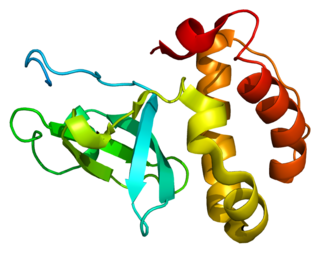
Condensins are large protein complexes that play a central role in chromosome assembly and segregation during mitosis and meiosis. Their subunits were originally identified as major components of mitotic chromosomes assembled in Xenopus egg extracts.
SMC complexes represent a large family of ATPases that participate in many aspects of higher-order chromosome organization and dynamics. SMC stands for Structural Maintenance of Chromosomes.

Cohesin is a protein complex that mediates sister chromatid cohesion, homologous recombination, and DNA looping. Cohesin is formed of SMC3, SMC1, SCC1 and SCC3. Cohesin holds sister chromatids together after DNA replication until anaphase when removal of cohesin leads to separation of sister chromatids. The complex forms a ring-like structure and it is believed that sister chromatids are held together by entrapment inside the cohesin ring. Cohesin is a member of the SMC family of protein complexes which includes Condensin, MukBEF and SMC-ScpAB.

Structural maintenance of chromosomes protein 1A (SMC1A) is a protein that in humans is encoded by the SMC1A gene. SMC1A is a subunit of the cohesin complex which mediates sister chromatid cohesion, homologous recombination and DNA looping. In somatic cells, cohesin is formed of SMC1A, SMC3, RAD21 and either SA1 or SA2 whereas in meiosis, cohesin is formed of SMC3, SMC1B, REC8 and SA3.

DNA (cytosine-5)-methyltransferase 3 beta, is an enzyme that in humans in encoded by the DNMT3B gene. Mutation in this gene are associated with immunodeficiency, centromere instability and facial anomalies syndrome.

SWI/SNF-related matrix-associated actin-dependent regulator of chromatin subfamily A member 5 is a protein that in humans is encoded by the SMARCA5 gene.

Structural maintenance of chromosomes protein 3 (SMC3) is a protein that in humans is encoded by the SMC3 gene. SMC3 is a subunit of the Cohesin complex which mediates sister chromatid cohesion, homologous recombination and DNA looping. Cohesin is formed of SMC3, SMC1, RAD21 and either SA1 or SA2. In humans, SMC3 is present in all cohesin complexes whereas there are multiple paralogs for the other subunits.

Kinesin family member 4A is a protein that in humans is encoded by the KIF4A gene.

A-kinase anchor protein 8 is an enzyme that, in humans, is encoded by the AKAP8 gene.

Wings apart-like protein homolog (WAPL) is a protein that in humans is encoded by the WAPAL gene. WAPL is a key regulator of the Cohesin complex which mediates sister chromatid cohesion, homologous recombination and DNA looping. Cohesin is formed of SMC3, SMC1, RAD21 and either SA1 or SA2. Cohesin has a ring-like arrangement and it is thought that it associates with the chromosome by entrapping it whether as a loop of DNA, a single strand or a pair of sister chromosomes. WAPL forms a complex with PDS5A or PDS5B and releases cohesin from DNA by opening the interface between SMC3 and RAD21.

Structural maintenance of chromosomes protein 4 (SMC-4) also known as chromosome-associated polypeptide C (CAP-C) or XCAP-C homolog is a protein that in humans is encoded by the SMC4 gene. SMC-4 is a core subunit of condensin I and II, large protein complexes involved in high order chromosome organization, including condensation and segregation. SMC-4 protein is commonly associated with the SMC-2 protein, another protein complex within the SMC protein family. SMC-4 dimerizes with SMC-2, creating the flexible and dynamic structure of the condensin holocomplex. An over-expression of the SMC-4 protein is shown to impact carcinogenesis.

Structural maintenance of chromosomes protein 6 is a protein that in humans is encoded by the SMC6 gene.

Condensin complex subunit 1 also known as chromosome-associated protein D2 (CAP-D2) or non-SMC condensin I complex subunit D2 (NCAPD2) or XCAP-D2 homolog is a protein that in humans is encoded by the NCAPD2 gene. CAP-D2 is a subunit of condensin I, a large protein complex involved in chromosome condensation.

Structural maintenance of chromosomes protein 5 is a protein encoded by the SMC5 gene in human.

Condensin-2 complex subunit D3 (CAP-D3) also known as non-SMC condensin II complex subunit D3 (NCAPD3) is a protein that, in humans, is encoded by the NCAPD3 gene. CAP-D3 is a subunit of condensin II, a large protein complex involved in chromosome condensation.

Condensin complex subunit 2 also known as chromosome-associated protein H (CAP-H) or non-SMC condensin I complex subunit H (NCAPH) is a protein that in humans is encoded by the NCAPH gene. CAP-H is a subunit of condensin I, a large protein complex involved in chromosome condensation

Condensin complex subunit 3 also known as condensin subunit CAP-G (CAP-G) or non-SMC condensin I complex subunit G (NCAPG) is a protein that in humans is encoded by the NCAPG gene. CAP-G is a subunit of condensin I, a large protein complex involved in chromosome condensation.

Condensin-2 complex subunit G2 (CAP-G2) also known as chromosome-associated protein G2 (CAP-G2) or leucine zipper protein 5 (LUZP5) is a protein that in humans is encoded by the NCAPG2 gene. CAP-G2 is a subunit of condensin II, a large protein complex involved in chromosome condensation. It interacts with PLK1 through its C-terminal region during mitosis

Condensin-2 complex subunit H2, also known as chromosome-associated protein H2 (CAP-H2) or non-SMC condensin II complex subunit H2 (NCAPH2), is a protein that in humans is encoded by the NCAPH2 gene. CAP-H2 is a subunit of condensin II, a large protein complex involved in chromosome condensation.

Structural maintenance of chromosomes protein 1B (SMC-1B) is a protein that in humans is encoded by the SMC1B gene. SMC proteins engage in chromosome organization and can be broken into 3 groups based on function which are cohesins, condensins, and DNA repair.SMC-1B belongs to a family of proteins required for chromatid cohesion and DNA recombination during meiosis and mitosis. SMC1ß protein appears to participate with other cohesins REC8, STAG3 and SMC3 in sister-chromatid cohesion throughout the whole meiotic process in human oocytes.





















